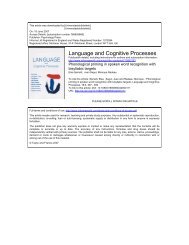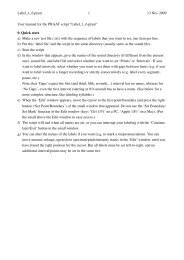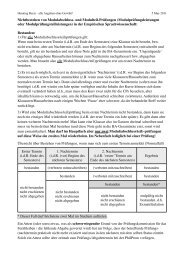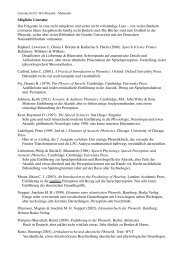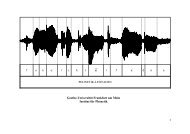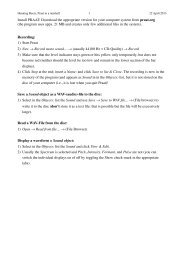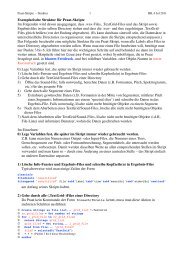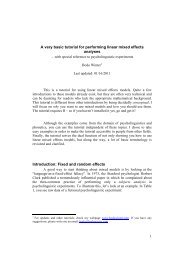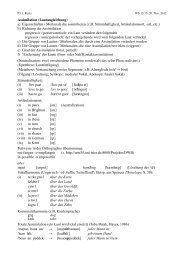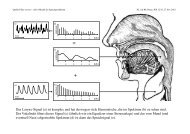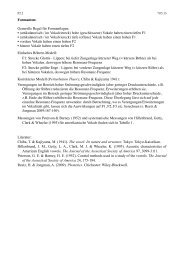Variation and assimilation in German - Institut für Phonetik
Variation and assimilation in German - Institut für Phonetik
Variation and assimilation in German - Institut für Phonetik
Create successful ePaper yourself
Turn your PDF publications into a flip-book with our unique Google optimized e-Paper software.
540 COENEN, ZWITSERLOOD, AND BOÈLTE<br />
changed words ( a weim, from we<strong>in</strong>, w<strong>in</strong>e) as a function of the viability of<br />
the follow<strong>in</strong>g context. So, available data on the importance of a licens<strong>in</strong>g<br />
context provide support <strong>in</strong> favour of <strong>and</strong> aga<strong>in</strong>st underspecication.<br />
EXPERIMENTAL CONSIDERATIONS<br />
In the present study, we manipulated contextual viability or appropriateness,<br />
the legality of the change <strong>and</strong> the direction of <strong>assimilation</strong> with<strong>in</strong> the<br />
same experiment, which constitutes an improvement on the methodology<br />
of earlier studies. Assimilation was always complete, result<strong>in</strong>g <strong>in</strong> a change<br />
<strong>in</strong> phoneme status (see note 2). We tested assimilated items <strong>in</strong> context<br />
(Experiment 1) <strong>and</strong> <strong>in</strong> isolation (Experiment 2). Our experiments<br />
exp<strong>and</strong>ed on the conditions under which <strong>assimilation</strong> has been <strong>in</strong>vestigated<br />
so far.<br />
Contextual viability or licens<strong>in</strong>g. As <strong>in</strong> most of the above experiments,<br />
we presented unchanged <strong>and</strong> changed words, <strong>in</strong> viable <strong>and</strong> unviable<br />
contexts. A context was viable when a segment <strong>in</strong> the context word<br />
conta<strong>in</strong>ed the feature that triggered the change <strong>in</strong> the segment <strong>in</strong>volved <strong>in</strong><br />
<strong>assimilation</strong>. An example is wort (word) changed to a worp before mal<br />
(just), with [m] conta<strong>in</strong><strong>in</strong>g the feature [labial]. The change was unviable<br />
when the context segment was <strong>in</strong>congruent with the change, as <strong>in</strong> worp<br />
before kurz (briey), with [k] conta<strong>in</strong><strong>in</strong>g the feature [velar]). Unlike the<br />
cases used by Marslen-Wilson et al. (1995), <strong>assimilation</strong> never resulted <strong>in</strong><br />
identical segments <strong>in</strong> assimilated <strong>and</strong> context words.<br />
Type of <strong>assimilation</strong>. So far, only <strong>assimilation</strong> of place of articulation<br />
was discussed. We tested two types of <strong>assimilation</strong>: Assimilation of place of<br />
articulation, <strong>and</strong> of voice. In place <strong>assimilation</strong>, a coronal feature can be<br />
realised as labial or velar, if an adjacent segment conta<strong>in</strong>s the labial or<br />
velar feature. Similarly, a voiced consonant can lose the feature [voiced] <strong>in</strong><br />
the context of a segment which is voiceless (see below).<br />
Direction of <strong>assimilation</strong>. We also varied the direction of <strong>assimilation</strong>,<br />
which can be regressive or progressive. So far, only regressive <strong>assimilation</strong><br />
has been <strong>in</strong>vestigated, with a context segment trigger<strong>in</strong>g a featural change<br />
<strong>in</strong> the preced<strong>in</strong>g segment. In progressive <strong>assimilation</strong> a featural change is<br />
triggered <strong>in</strong> a follow<strong>in</strong>g segment (e.g., a hemp for hemt, shirt or a lebmde for<br />
lebnde, liv<strong>in</strong>g). As the examples show, progressive place <strong>assimilation</strong> is<br />
attested word-<strong>in</strong>ternally <strong>in</strong> <strong>German</strong>, not across word boundaries (Kohler,<br />
1995). Our experiments were designed to test the general idea of<br />
underspecication, as well as assumptions about a special status of wordonsets<br />
<strong>in</strong> word recognition (Marslen-Wilson & Zwitserlood, 1989). We



